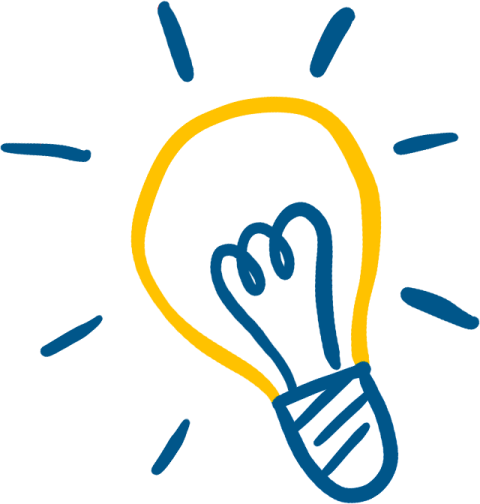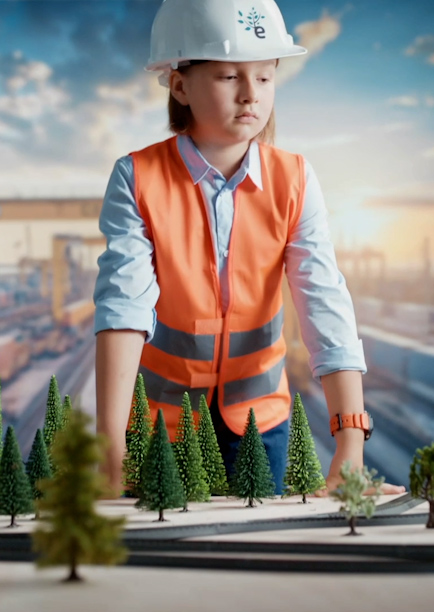Clean Energy Solutions
to Power a Growing World
Just as young kids need extra energy to fuel their growth spurts, our planet will need a surge of sustainable power to support its own development. According to the IEA, by 2050 demand for electricity could be up to 150% higher than it was in 2022.
Our future energy mix must not only be able to power this dynamic world, but do so while cutting carbon emissions, reducing waste products, preserving limited natural resources, and complying with ever-evolving sustainability regulations and ESG imperatives.
Clean energy generation sources, like renewable energy and nuclear power will of course play a central role. But this future also requires other innovations, such as transformed transmission and distribution networks, scaled-up energy storage systems and next-generation smart grid management solutions.
A World Rebuilt on Clean Energy
There is no one-size-fits-all solution to the global clean energy transition. Different territories will adopt different energy systems depending on local circumstances and capabilities.
France, for example, already derives 70% of its electricity from nuclear sources1, and many other countries have identified nuclear as a key part of their future clean energy mix.
However, delivering new power stations is incredibly costly, complex, and time-consuming – all of which can be off-putting for investors. “I’ve seen developers drop projects because they just did not see a viable business model. There are just too many uncertainties,” says Audrey Goulven, Sustainable Infrastructure and Clean Energy Director, Dassault Systèmes.
This is where emerging technologies like Small Modular Reactors (SMRs) and Advanced Modular Reactors (AMRs) could make a big difference. France’s NAAREA, for example, is pioneering a compact, flexible, and low carbon AMR that can be deployed much more easily and flexibly than traditional large-scale facilities.
And NAAREA is supporting and de-risking their projects with digital solutions. By starting with a virtual model of their experimental new reactors, built using Dassault Systèmes’ 3DEXPERIENCE platform, they weren’t just able to streamline design processes, but also create more investable products.
“Realistic representations of the reactor are key for communicating to our partners, stakeholders, investors and customers what they’re investing in and the journey we’re on,” says Jean-Luc Alexandre, founder and CEO of NAAREA.
Why We Need More Clean Energy than Ever
Renewable energy sources will also be key. Indeed, research from McKinsey anticipates that we will need a fourfold increase in the deployment of new energy technologies, such as solar and wind, to meet global net-zero commitments. By 2050, renewables could account for up to 85% of global electricity production2.
The speed of scaling new energy technologies needs to grow x 4 to meet global net-zero commitments:
Low-carbon energy generation (wind, solar, and other) as share of the energy mix.
1/3 of our energy needs to come from low-carbon sources to reach these targets in the next decades.

The Problem of Intermittency in Renewable Energy Infrastructure
However, the reliance of some renewable energy sources on weather conditions – like wind and solar – can cause unpredictable peaks and troughs in production. This so-called “intermittency” puts pressure on suppliers, on energy storage providers, and on transmission and distribution system operators. These pressures must be addressed with the provision of new infrastructure like smart grids, new business models, and even new storage techniques.
“With fossil-fuel-based electricity production, the grid was a very high voltage network, designed to connect from a specific point,” says Goulven. “But now, we must expand that grid diffusely, and often the necessary transmission and storage solutions just don’t exist.” Globally, Bloomberg projects that the grid of the future will require more than 150 million km of infrastructure – more than double the length of today’s global electricity grid.
Without those interconnections, projects simply cannot get off the ground. According to Bloomberg, there were nearly 1,000GW of solar power across the US and Europe stuck in the interconnection queue as of 20233. Or take wind, which could account for as much as 35% of global electricity production by 20504 – it too is being held back by a lack of adequate infrastructure. In the UK alone, around 200GW offshore wind power was waiting to be connected to the grid.
Managing Complex Energy Infrastructure in Real Time
But what happens once generators are switched on and infrastructure is connected?
It then becomes a question for power grid management stakeholders, such as Transmission Systems Operators (TSOs) and Distribution System Operators (DSO). These entities must ensure that electricity is delivered to all users, at all times, at the lowest possible price. They achieve this in two ways.
One is by operating and maintaining networks – TSOs, for instance may be responsible for designing, engineering, building, operating, and maintaining power lines and interconnections. The other is by balancing supply and demand, which is achieved by matching buyers and sellers on energy markets.
Traditionally, this was done on linear networks, where energy and information flowed in one direction – from the generator to the consumer. However, recent decades have seen markets deregulate and new models emerge, characterized by the increasing prominence of end-users who are also producers, like homeowners with roof-mounted solar panels, or municipally-owned solar plants.
Consequently, those old linear networks are now becoming more complex, with energy flowing bidirectionally. This significantly complicates the task for operators.
By using virtual twins to generate an end-to-end, multi-scalar view of assets in their given environmental context and establish a common data environment for all power system stakeholders, generators, TSOs and DSOs can anticipate engineering, operational, construction, and maintenance needs and ensure the production and delivery of power that is reliable, reasonably priced, and sustainable.
Training for Transition: Tomorrow’s Energy Experts
The potential of clean energy is enormous. But to transition at the scale we need demands skilled labor at a time when industry is already struggling with shortages. In the EU alone, it is estimated that a million new – and increasingly digitally driven – jobs will be required. Understanding how to use virtual twins for energy transition technologies will be essential to the energy sector workforce of tomorrow.
This transition presents a huge opportunity for a new generation, eager to make a meaningful societal impact through their careers. It’s why Dassault Systèmes is excited to be sponsoring student competitions focused on sustainable technologies. This includes AAKRUTI Innovation Competition 2025, a worldwide design contest that allows participants to think about how to transition to clean energy by innovating both locally and globally – all part of inspiring the next-generation of world-changing young talent.
Don't miss Amy on Disruptors Unleashed!
In this podcast episode, Thierry Chevrot, 3DEXPERIENCE Edu lead at Dassault Systèmes, and 9-year-old Infrastructor Amy explore how we can bring industry into the classroom and transform students of today into the next generation of sustainable innovators.


FAQ about Clean & Green Energy
Renewable energy transition for industries is important because it reduces greenhouse gas emissions, combats climate change, and decreases dependence on finite fossil fuels. It also promotes energy security and sustainability, ensuring a cleaner, healthier environment for future generations.
A clean energy transition is a comprehensive strategy aimed at shifting from fossil fuels and nuclear power to renewable energy sources such as wind, solar, and biomass. Key elements include expanding renewable energy capacity, phasing out non-renewable energy sources, improving energy efficiency, modernizing the electricity grid, and developing energy storage solutions. The initiative is typically supported by policies and legislation that provide incentives and long-term strategies for reducing greenhouse gas emissions. Public participation, job creation, and innovation are central to a successful clean energy transition, demonstrating how comprehensive policy measures, technological advancements, and societal engagement can drive significant progress towards a sustainable energy future.
An example of a clean energy transition is a country shifting from coal-fired power plants to solar, wind, and nuclear energy. This involves replacing old, polluting energy sources with renewable and low-emission alternatives to reduce carbon emissions and promote sustainability.
As of 2023, approximately 81.5% of global energy is produced by fossil fuels, which includes coal, oil, and natural gas. This percentage has slightly decreased from previous years, but fossil fuels still dominate the global energy mix.
Renewable sources, such as solar, wind, and hydropower, are central to the clean energy transition. They provide a sustainable alternative to fossil fuels by generating energy without emitting greenhouse gases. The shift towards these renewable sources is crucial for reducing global carbon emissions and mitigating climate change, making them key components of the broader effort to achieve a cleaner and more sustainable energy future.
Clean energy closely aligns with several Sustainable Development Goals (SDGs). It supports:
SDG 7, Affordable and Clean Energy: by providing access to reliable, sustainable, and modern energy sources like solar and wind, thereby enhancing energy security and reducing reliance on fossil fuels.
SDG 9, Industry, Innovation, and Infrastructure: by driving the development of sustainable infrastructure and fostering innovation in energy systems, which fuels technological advancements and industrial growth.
SDG 13, Climate Action: by producing minimal greenhouse gases, helping to mitigate climate change and supporting efforts to build resilience and adaptation to its impacts.
The CETI (Clean Energy Transition Initiative) plays a crucial role in shaping policies and regulations that support the clean energy transition. It collaborates with governments and organizations to develop and implement strategies that set renewable energy targets, provide incentives for clean energy investments, and ensure a favorable regulatory environment for sustainable energy projects.
Yes — clean energy represents a strong long-term investment opportunity as global demand for sustainable power continues to rise. According to the IEA, electricity demand could increase by up to 150 % by 2050, driving the need for expanded renewable generation, advanced nuclear technologies, large-scale storage, and smart grid infrastructure.
While traditional power projects can be costly and complex, innovations such as Small Modular Reactors (SMRs), digital twin technology, and smart grid management are helping reduce risks, streamline development, and make projects more attractive to investors. As countries accelerate their energy transitions to meet net-zero goals, clean energy infrastructure is set to play a central role in powering growth, fostering innovation, and delivering stable, long-term returns.






